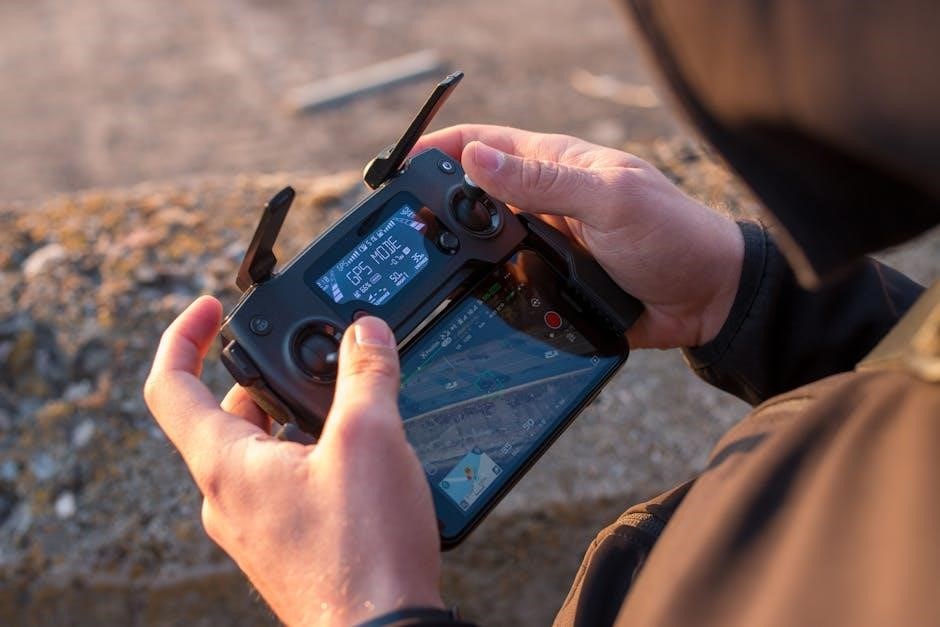The Hayman Reese Brake Controller is a crucial towing accessory designed to ensure safe and controlled braking for trailers. It offers proportional control, easy installation, and manual override functionality, making it a reliable choice for various towing needs.
Overview of the Hayman Reese Brake Controller
The Hayman Reese Brake Controller is a high-quality towing solution designed to regulate trailer braking seamlessly. It offers proportional control, ensuring smooth braking proportional to the vehicle’s deceleration. Available in models like the Compact IQ and Guardian, it suits trailers with 1-3 axles. The controller features a user-friendly interface with a digital display and manual override for emergency braking. Compatible with 12-volt systems, it ensures safe and efficient towing. Its slim design allows versatile mounting options, enhancing convenience. The system also includes advanced diagnostic features for troubleshooting and LED indicators for connection status. Designed for durability and reliability, the Hayman Reese Brake Controller is a trusted choice for towing enthusiasts, providing precise control and enhanced safety on the road.
Importance of the User Manual
The user manual for the Hayman Reese Brake Controller is essential for optimal performance and safety. It provides detailed instructions for installation, operation, and troubleshooting, ensuring proper setup and usage. The manual outlines pre-installation checks, wiring diagrams, and mounting guidelines, helping users avoid common errors. It also explains how to calibrate the controller and use features like manual override. Understanding the manual prevents potential issues, enhances towing safety, and prolongs the product’s lifespan. By following the guidelines, users can maximize efficiency, ensure compliance with safety standards, and enjoy a hassle-free towing experience. Regular maintenance tips and diagnostic procedures are also included, making the manual an indispensable resource for all users.
Types of Hayman Reese Brake Controllers
Hayman Reese offers two primary types of brake controllers: proportional and time-activated. Proportional controllers adjust braking force based on the vehicle’s deceleration, providing smooth and synchronized stops. They are ideal for heavy-duty towing and varying load conditions. Time-activated controllers apply brakes after a preset delay, offering simplicity for lighter towing needs. Both types are designed for compatibility with 1, 2, or 3-axle systems, ensuring flexibility for different towing setups. Understanding these options helps users select the most suitable controller for their specific requirements, ensuring safe and efficient braking performance. Each type includes features like manual override and LED indicators for enhanced control and monitoring. Proper selection guarantees optimal towing safety and convenience.

Installation Instructions
Ensure compatibility with your vehicle’s electrical system, mount the controller securely, and follow wiring guidelines for proper setup. Always refer to the user manual for precise steps.
Pre-Installation Checks
Before installing the Hayman Reese Brake Controller, ensure your vehicle is equipped with a 12-volt negative ground system. Locate the orange power and white ground terminals in your vehicle’s wiring harness. Verify compatibility with your trailer’s braking system and the number of axles it supports. Check that all components, including the mounting hardware, are included in the kit. Disconnect the negative battery cable to prevent electrical shocks during installation. Review the user manual to understand specific requirements for your setup. Ensure the brake controller is compatible with your tow bar and vehicle make. Proper preparation ensures a safe and efficient installation process.
Mounting the Brake Controller
Mount the Hayman Reese Brake Controller in a secure, easily accessible location within your vehicle cabin. Use the provided mounting bracket and hardware to ensure stability. Attach the unit to a flat, level surface to prevent interference with its proportional sensing technology. Avoid areas exposed to water or extreme temperatures. Ensure the control is within reach for safe operation during towing. Follow the manual’s guidelines for proper positioning and alignment. Secure all screws tightly to prevent vibration damage. Proper mounting ensures optimal performance and durability of the brake controller.
Wiring Connections and Setup

Connect the Hayman Reese Brake Controller according to the wiring diagram provided in the user manual. Ensure compatibility with your vehicle’s 12V negative ground system. Attach the black wire to the battery’s positive terminal and the white wire to a suitable ground. The brake signal wire connects to the vehicle’s brake light circuit; Use weatherproof connectors to protect against moisture. Double-check all connections to avoid electrical issues. Power on the controller and test the display for proper function. Refer to the manual for specific wiring instructions tailored to your vehicle and trailer setup. Correct wiring ensures safe and efficient operation of the brake controller. Always disconnect the negative battery terminal before starting the wiring process to prevent electrical shocks or damage.

Operating the Brake Controller
The Hayman Reese Brake Controller operates by sensing vehicle deceleration and applying proportional braking to the trailer. Use the manual override for instant brake engagement and adjust settings for optimal control and safety during towing.
Initial Setup and Calibration

For the Hayman Reese Brake Controller, begin with mounting and wiring according to the manual. Connect the black wire to the vehicle’s battery and ensure all terminals are secure. Set the brake controller to your vehicle’s voltage system, typically 12V negative ground. Perform a system test by pressing the manual override button to confirm trailer brakes engage. Adjust sensitivity settings based on trailer weight and driving conditions. Calibration ensures proportional braking, syncing trailer brakes with vehicle deceleration. Follow the user manual for precise steps to achieve optimal performance and safety during towing.
Manual Override and Adjustments
The Hayman Reese Brake Controller features a manual override button, allowing direct control of the trailer brakes. This function is useful for emergencies or additional braking in specific conditions. To use the override, press the button on the front of the unit; the trailer brakes will engage independently of the vehicle’s brakes. Adjustments can be made using the rotary control knob to fine-tune braking sensitivity. This ensures smooth and proportional braking, tailored to the trailer’s weight and driving conditions. Regular adjustments may be needed for different loads or towing scenarios. Always refer to the user manual for guidance on optimal settings to ensure safe and efficient braking performance during towing.
Understanding the Display and LED Indicators
The Hayman Reese Brake Controller features a digital display and LED indicators to provide real-time feedback on braking operations. The display shows the current synchronization setting and trailer brake activity, while the LEDs indicate system status, connection confirmation, and error codes. A solid green LED signals proper connection, while flashing or red LEDs may indicate issues like loss of connection or short circuits. The display also shows manual override activation and adjustment levels, allowing for precise control. Understanding these indicators ensures proper functionality and safety during towing. Refer to the user manual for a detailed explanation of all display symbols and LED meanings to interpret and address any system notifications effectively.

Maintenance and Troubleshooting
Regularly inspect wiring connections, clean the brake controller, and check battery levels to ensure optimal performance. Refer to the manual for troubleshooting common issues like error codes or connectivity problems.
Regular Maintenance Tips
Regular maintenance ensures the Hayman Reese Brake Controller operates efficiently. Inspect wiring connections for corrosion or damage, and clean the controller periodically. Check the battery voltage to prevent power issues. Ensure the manual override function is tested occasionally. Verify that all LED indicators are functioning correctly, as they provide critical status updates. Review the user manual for specific maintenance schedules tailored to your controller model. Always follow the manufacturer’s guidelines for software updates and firmware installations. Proper care extends the lifespan of your brake controller and enhances towing safety. Addressing minor issues promptly prevents major malfunctions during use.
Troubleshooting Common Issues
Common issues with the Hayman Reese Brake Controller include error codes on the display, wiring connectivity problems, or inconsistent brake activation. Start by checking all wiring connections for corrosion or damage, ensuring they are securely attached. Verify the ground wire connection, as a loose ground can cause malfunction. If the display shows an error, refer to the user manual for code meanings and resolution steps. Test the manual override function to ensure it activates the brakes correctly. For software-related issues, perform a reset or update the firmware following the manual’s instructions. Always consult the troubleshooting section of the user manual for specific solutions tailored to your controller model. Regular checks and prompt issue resolution ensure reliable performance and safety while towing.
Advanced Diagnostic Features
The Hayman Reese Brake Controller incorporates advanced diagnostic features to enhance functionality and user experience. It offers self-diagnostic capabilities, monitoring connections and trailer brake engagement. The LED display provides real-time feedback, highlighting issues like short circuits or incorrect wiring. The controller also features automatic synchronization with compatible tow vehicles. For precise adjustments, it includes settings for brake force and synchronization levels, accessible via the control knob. These features ensure optimal braking performance, adaptability to various towing conditions, and ease of troubleshooting. By utilizing these advanced diagnostics, users can maintain safe and efficient trailer braking systems, minimizing potential risks and enhancing overall towing confidence.
The Hayman Reese Brake Controller user manual provides essential guidance for safe and efficient towing. For further details, refer to official manuals and online resources.

Key Takeaways from the User Manual
The Hayman Reese Brake Controller manual emphasizes proper installation, wiring, and calibration for optimal performance. Regular maintenance and understanding LED indicators are crucial for safe towing. Always follow the manual’s guidelines for troubleshooting common issues and utilizing advanced diagnostic features to ensure reliable braking control. Proper synchronization with the vehicle’s braking system enhances safety, and the manual override feature provides additional control during emergencies. Familiarizing oneself with the digital display and rotary knob adjustments ensures precise braking force management. Adhering to these guidelines ensures a secure and efficient towing experience, making the Hayman Reese Brake Controller a dependable choice for trailers and caravans.
Recommended Further Reading
For a deeper understanding, refer to the official Hayman Reese Brake Controller User Manual, available on their website. Additional resources include the REDARC Tow-Pro Manual and the CaravansPlus.com.au guide, which offers detailed installation and operation insights. The Hayman Reese Wiring Instructions document provides clear diagrams for proper connections. Lastly, explore the Hayman Reese Guardian Instructions for advanced troubleshooting and diagnostic features, ensuring optimal performance and safety while towing.

Leave a Reply
You must be logged in to post a comment.